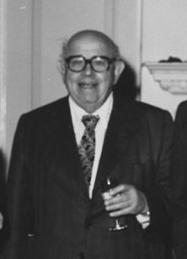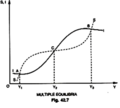Nicholas Kaldor facts for kids
Quick facts for kids
The Lord Kaldor
|
|
|---|---|
 |
|
| Born |
Káldor Miklós
12 May 1908 Budapest, Hungary
|
| Died | 30 September 1986 (aged 78) Papworth Everard, Cambridgeshire, England
|
| Nationality | British |
| Field | Political economy |
| School or tradition |
Post-Keynesian economics |
| Doctoral advisor |
Allyn Abbott Young Lionel Robbins |
| Doctoral students |
Frank Hahn |
| Influences | John Maynard Keynes, Gunnar Myrdal |
| Contributions | Kaldor–Hicks efficiency Kaldor's growth laws Circular cumulative causation |
Nicholas Kaldor (born Káldor Miklós, 12 May 1908 – 30 September 1986) was an important economist from Cambridge in the years after World War II. He helped create ideas like Kaldor–Hicks efficiency, which is a way to compare how well different economic choices help people. He also studied how economies grow and change, coming up with ideas like Kaldor's growth laws.
Kaldor worked with another economist named Gunnar Myrdal to develop the idea of Circular Cumulative Causation. This idea explains how different parts of an economy are connected and can cause each other to grow or shrink in a cycle. Myrdal focused on how societies provide for their people, while Kaldor looked at how demand and supply affect factories and production. Kaldor also came up with the term "convenience yield" for commodity markets, which is about the extra value of having a physical product right away.
Contents
About Nicholas Kaldor
Nicholas Kaldor was born in Budapest, Hungary. His father was a lawyer, and his mother was a very smart and educated woman. He studied in Budapest, Berlin, and at the London School of Economics (LSE). He earned a top degree in economics in 1930.
After graduating, he became a teacher and later a professor of economics at the LSE. From 1943 to 1945, Kaldor worked for a research group. In 1947, he left the LSE to lead research and planning at the Economic Commission for Europe. In 1949, he moved to King's College, Cambridge, where he became a professor in 1966.
Government Advisor and Peerage
Starting in 1964, Kaldor became an advisor to the Labour government in the UK. He also advised other countries. He was one of the first people to suggest creating a value added tax, which is a tax on goods and services.
He also helped create the Selective Employment Tax (SET) for the government of Harold Wilson. This tax aimed to tax jobs in service industries while helping jobs in manufacturing. In 1974, he was given the special title of Baron Kaldor, which made him a life peer in the UK.
Kaldor was invited by India's Prime Minister, Jawaharlal Nehru, in the 1950s. He helped design a tax system for India. Later, his family gave his large collection of economics books to the Centre for Development Studies (CDS) Library in India. This collection has 362 books on many economic topics.
Understanding Economic Cycles
Economists like Nicholas Kaldor have tried to understand why economies go through periods of growth (booms) and slowdowns (busts). This is called the business cycle. After John Maynard Keynes wrote his famous book, The General Theory, many economists tried to build models to explain these cycles.
Kaldor created a model in 1940 that explained how the economy naturally cycles. His idea was that investment (money spent by businesses) depends on how much income people have and how much capital (like factories and machines) businesses already own.
When people's income grows, businesses tend to invest more because they expect more demand in the future. But if businesses already have a lot of factories and machines, they might not want to invest in more. Kaldor also believed that how much people save changes during different parts of the cycle. For example, during a slowdown, people might save less to keep their lifestyle. During good times, they might save more.
Kaldor's ideas showed that the economy's ups and downs are a natural part of how it works. He believed that the economy has built-in ways to prevent these cycles from becoming too extreme. For example, he thought that how money is shared between workers and business owners could help balance the economy.
Personal Life
Nicholas Kaldor was married to Clarissa Goldsmith. She was well-known in Cambridge. They had four daughters: Penny Milsom, Katharine Hoskyns, Frances Stewart, and Mary Kaldor. All of his daughters have achieved success in their own fields.
He passed away in Papworth Everard, Cambridgeshire.
Images for kids
See also
 In Spanish: Nicolás Kaldor para niños Kaldor's facts Kaldor's growth laws Technical progress function
In Spanish: Nicolás Kaldor para niños Kaldor's facts Kaldor's growth laws Technical progress function




